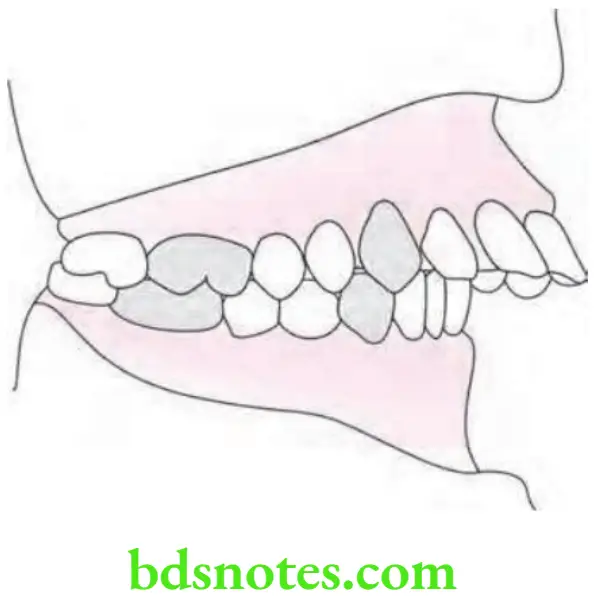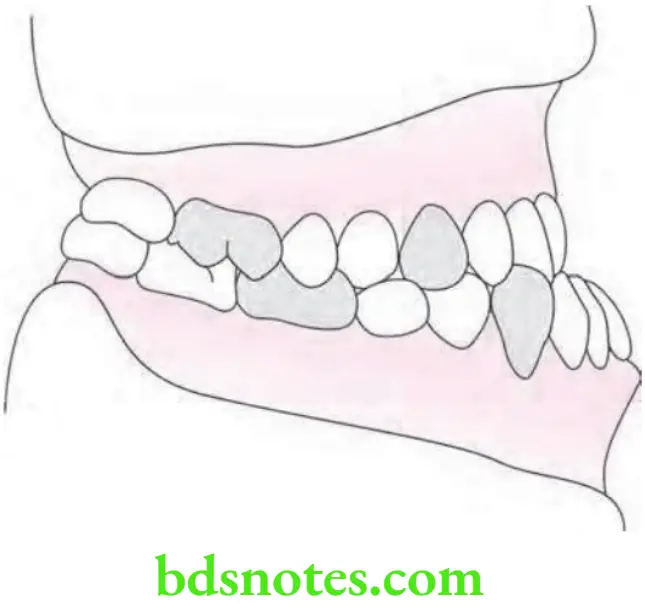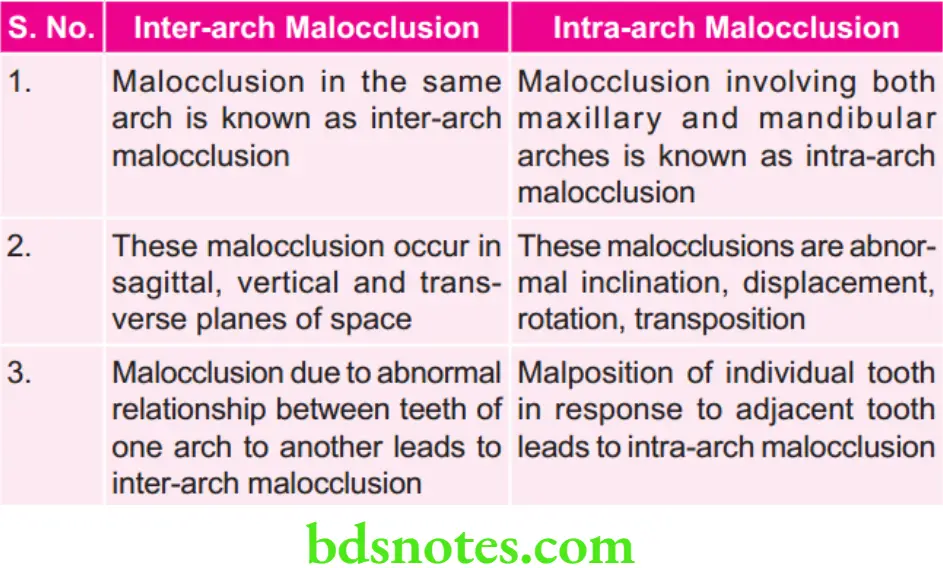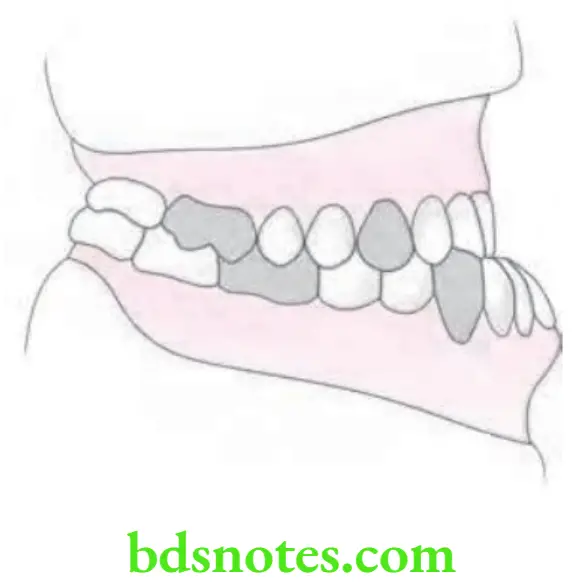Classification Of Malocclusion
Question 1. Define malocclusion. Describe the Angle’s classification of malocclusion.
Or
Write Angle’s classification of malocclusion.
Or
Write short note on Angle’s classification.
Answer. Malocclusion is a condition in which there is a departure from normal relation of the teeth to other teeth in the same arch and/or to teeth in opposing arch. Gardiner, White and Leighton
Angle’s Classification of Malocclusion
Edward Angle introduced a system of malocclusion in 1899.
- Angle’s classifiation was based on the mesiodistal relation of the teeth, dental arches and the jaws.
- According to Angle the maxillary fist permanent molar is the key of occlusion.
- Based on the relation of the lower 1st permanent molar to the upper 1st permanent molar, Angle classified malocclusion into 3 main classes:
Angle’s Class 1 Malocclusion (Neutrocclusion)
Molar relation: Mesiobuccal cusp of maxillary fist permanent molar occludes in mesiobuccal groove of mandibular fist permanent molar.

Canine relation: Mesial inclination of maxillary canine occludes with distal inclination of mandibular canine whereas distal inclination of maxillary canine occludes with mesial inclination of mandibular fist premolar.
Read And Learn More: Orthodontics Question And Answers
Line of occlusion: It get alter in maxillary and mandibular arches.
- Tooth irregularities like crowding, spacing, missing of tooth and rotations are seen.
- Interarch problems such as deep bite, increased overjet, cross bite and open bite are seen.
Class 1 Bimaxillary Protrusion
It is a condition in which key of occlusion and line of occlusion are not altered, but maxillary and mandibular anteriors are proclined and exist in edge-to-edge relationship.
Angle’s Class 2 Division 1 Malocclusion (Distocclusion)
Molar relation: This group is characterized by class II molar relation where the distobuccal cusp of permanent maxillary fist molar occludes in the buccal groove of permanent mandibular fist molar.

Class 2 canine relation: Distal incline of maxillary canine occludes with mesial inclines of mandibular canine.
Line of occlusion: It will get altered. Various other features of class 2 division 1 malocclusion are:
- Proclined maxillary incisors.
- Deep bite.
- Lip trap.
- V-shaped maxilla.
- Exaggerated curve of Spee.
Class 2 division 1 subdivision: In this there is unilateral class 2 molar relationship with normal class 1 molar occlusion over other side.
Angle’s Class 2 Division 2 Malocclusion
Class 2 molar relation: Mandibular arch is distally positioned in relation to maxillary arch. Distobuccal cusp of maxillary fist molar occludes with mesiobuccal groove of mandibular fist molar.
Class 2 canine relation: Distal incline of maxillary canine occludes with the mesial incline of mandibular canine.
Line of occlusion: It becomes altered.

- Other Features: Arch become square shaped.
- Curve of Spee is exaggerated.
- Close bite.
- Lingual inclination of maxillary central incisor or lingual inclination of both maxillary central and lateral incisors.
- Retroclined incisors overlapped by canine.
Class 2 division 2 subdivision: Class II molar relation occur on one side with normal molar relation on other side.
Angle’s Class 3 Malocclusion (Mesiocclusion)
Class 3 molar relation: Mesiobuccal cusp of maxillary fist permanent molar occlude with interdental space between mandibular fist and second permanent molars.
Class 3 canine relation: Maxillary canine occludes with interdental space between mandibular first and second premolars.
Line of occlusion: It can or cannot be developed.

Other Features:
- Anterior crossbite
- Posterior crossbite
- Maxillary anterior crowding.
Class 3 subdivision: In this class III molar relation is present over one side with normal molar relation to other side.
True Class 3:
It is a skeletal malocclusion.
Causes are prognathic mandible, retrognathic maxilla, combination of both.
Pseudo Class 3:
- It occurs because of occlusal prematurities, when the mandible moves from rest to occlusion, it slide forward into pseudo class III malocclusion.
- In rest position patient show normal molar relationship.
Question 2. Write short note on pseudo class 3.
Or
Write short note on pseudo class 3 malocclusion.
Or
Give aetiology of pseudo class 3 malocclusion.
Answer. It is type of class 3 malocclusion of Angle’s classification.
- This type of malocclusion is produced by a forward movement of the mandible during jaw closure. Thus, it is also called postural or habitual class III malocclusion.
- Patient exhibit normal molar relationship during the rest position.
- In centric occlusion patient show class 3 relationship.
Causes of Class III Pseudo Malocclusion
- Presence of occlusal prematurities may deflect the mandible forward.
- Premature loss of deciduous posterior teeth, the child tends to move the mandible forward to establish contact in the anterior region.
- A child with enlarged adenoids tends to move mandible forward in an attempt to prevent the tongue from contacting the adenoids.
Question 3. Write short note on Dewey’s modification.
Or
Write short note on Dewey’s modification for Angle’s class 3 and 3 malocclusion.
Answer. Dewey’s proposed a modification of the Angle’s classification of malocclusion.
Dewey’s divided Angle’s class 1 into 5 types and Angle’s class 3 into 3 types. Class 2 has no types.
Class 1 Modifiation of Dewey
Type 1: Class 1 malocclusion with bunched or crowded anterior teeth.
Type 2: Class 1 malocclusion with protrusive maxillary incisors.
Type 3: Class 1 malocclusion with anterior crossbite.
Type 4: Class 1 malocclusion with posterior crossbite
Type 5: Permanent molar has driftd mesially due to early extraction of second deciduous molar or second premolar.
Class 3 Modifiation of Dewey
Type 1: Individual arches when viewed individually are in normal alignment, but when in occlusion the anteriors are in edge-to-edge alignment.
Type 2: Mandibular incisors are crowded and are in lingual relation to the maxillary incisors.
Type 3: Maxillary incisors are crowded and are in crossbite in relation to the mandibular anterior.
Question 4. Discuss any one classification of malocclusion giving its merit and demerits.
Or
Describe Angle’s classification of malocclusion. What are the merits and demerits of this classification.
Answer. Angle’s classification— Refer to Ans 1 of same chapter
Merits
- Easy identifiation of malocclusion.
- Easy for reference.
- Easy for comparison.
- Easy for self-communication.
- Easy for treatment plan.
Demerits
- Does not consider malocclusion in transverse and vertical planes. Angle considered only sagittl dimension.
- Angle considered the fist permanent molar as fied point of skull, but this is not found to be so.
- The classifiation can not be applied if the fist permanent molars are missing or extracted.
- This classification cannot be applied in deciduous denitition.
- Does not differentiate between skeletal and dental malocclusion.
- Does not diffrentiate between true and pseudo class III malocclusion.
- Growth of bones and muscle malfunction were overlooked. They influence position of molars.
- Etiology of malocclusion is unknown.
- Only static occlusion is considered by Angle’s classification.
Question 5. Name various classifications of malocclusion. Describe Simon’s classification giving its merits and demerits.
Or
Write briefly on Simon’s classification.
Or
Describe Simon’s classification.
Or
Write a short note on Simon’s classification of malocclusion
Answer. Various classifications of malocclusion:
- Angle’s system of classification.
- Dewey’s modification of Angle’s classification.
- Simon’s classification.
- Lischer modification of Angle’s classification.
- Bennett’s classification.
- Ackerman-Proffit system of classification.
Simon’s Classification
- Simon give a craniometric classification of malocclusion that relate the dental arches in all the three planes.
- Simon’s system of classification made use of three anthropometric planes, i.e. the Frank horizontal plane, the orbital plane and the mid-sagittl plane.
- Malocclusion is described as deviation of arches from their normal position in relation to three planes.
Frankfort Horizontal Planes(vertically) or EyeEar Plane
- This is a plane that connect the upper margin of the external auditory meatus to the infraorbital margin.
- This plane is used to classify malocclusion in a vertical plane.
- When the dental arch is closer to the normal Frankfort horizontal plane—Attraction.
- When the dental arch is further away from normal FH plane—Abstraction.
Orbital Plane (Anteroposteriorly)
- This plane is perpendicular to FH plane dropped down from the bony orbital margin directly under the pupil of eye.
- Used for anteroposterior plane.
- Simon’s law of canine—This plane connects infraorbital margin to distal of canine.
- If the arch is closer to the plane—Retraction.
- If the arch is further away from normal orbital plane—Protraction.
Midsagittal Plane or Raphae Median Plane
- This plane passes from midsagittal line.
- This is used to describe malocclusion in the transverse direction.
- When the arch is closer to the normal midsagittl plane—Contraction.
- When the arch is away from the midsagittal plane—Distraction.
Demerits of Simon’s Classification
- It does not show that malocclusion is skeletal or dental.
- It does not show that malocclusion is one sided or on both side.
- It does not show abnormal position of one or more teeth (single/generalized).
- It does not differentiate that malocclusion is developmental or due to local factors.
Merits of Simon’s Classification
Simon had given the classification which is oriented to dental arch and to three different planes. This means that malocclusion is a three dimensional problem.
Interpretation of Simon’s Classification

Question 6. Write short note on drawbacks of Angle’s classification.
Or
Write short note on disadvantages of Angle’s classification.
Or
Write short answer on drawbacks of Angle’s classification of malocclusion.
Answer.
Drawbacks of Angle’s classification
- Does not consider malocclusion in transverse and vertical planes. Angle considered only sagittl dimension.
- Angle considered the fist permanent molar as fied point of skull, but this is not found to be so.
- The classifiation cannot be applied if the fist permanent molars are missing or extracted.
- This classifiation cannot be applied in deciduous dentition.
- Does not differentiate between skeletal and dental malocclusion.
- Does not diffrentiate between true and pseudo class III malocclusion.
- Growth of bones and muscle malfunction were overlooked. They influence position of molars.
- Etiology of malocclusion is unknown.
- Only static occlusion is considered by Angle’s classification.
Question 7. Write short note on AckermanProffit classification of malocclusion.
Or
Briefly describe AckermanProffit classification.
Answer. Ackerman and Proffit proposed this classification in 1960 to overcome the limitations of the Angle’s classification.
AckermanProffit Classifiation
Group 1 (Alignment)
The fist step involves assessment of the alignment and symmetry of the dental arch. It is classified as ideal crowded/ spaced.
Group 2 (Profie)
It involves the consideration of the profile. The profile is described as convex/straight/concave. The facial divergence is considered, i.e. anterior or posterior divergence.
Group 3 (Type)
The transverse skeletal and dental relationship is evaluated. Buccal and palatal crossbites, if any are noted. The cross bite is further classified as unilateral or bilateral. In addition, differentiation is made between skeletal and dental crossbite.
Group 4 (Class)
This involves the assessment of the sagittal relationship. It is classified as Angle’s Class I/Class II/Class III malocclusion. Differentiation is made between dental and skeletal malocclusion.
Group 5 (Bite Depth)
Malocclusions in vertical plane are noted. They are described as anterior or posterior open bite, anterior deep bite or posterior collapsed bite. A mention is made whether the malocclusion is skeletal or dental.
Advantages
- Complexities of malocclusion are explained.
- In addition to the anteroposterior malrelations, transverse as well as vertical discrepancies are taken in consideration i.e. all of the three planes should be considered.
- Profie of the patient should be given due consideration.
- It is easy to make diffrentiation between the skeletal and dental problems.
- It helps in formulating complete diagnosis and differential treatment planning.
- It is always readily acceptable for computer processing.
Disadvantages
- This classification should not consider the etiological aspects
- The classification is based only on the static occlusion while functional occlusion should not being considered.
Question 8. Write short note on venn’s diagram.
Or
Write short note on venn diagram of classification of malocclusion.
Answer. In orthodontics, an instrument designed by Ackerman and Proffit to attempt to differentiate the many different kinds of problems seen in each of the malocclusion cases defied by Angle.

Venn diagram adds four other factors (an assessment of tooth alignment, facial profie, transverse problems, and vertical problems) to Angle’s mesiodistal (sagittl) classes of malocclusion.
Description of venn’s Diagram
Group 1 (Intraarch Alignment and Symmetry)
- In this group analysis of alignment as well as symmetry is done. Various individual tooth irregularities are described.
- Possible malocclusions are crowding, rotations, spacing and the mutilated conditions.
- If abnormalities are not present it is known as ideal.
- As degree of alignment and symmetry is common to all dentition, it is known as Group 1
Group 2 (Profie)
- As we proceed inside the Venn diagram, profie of patient should be studied.
- So in this group the possibilities are straight profile, convex profile, concave profile and anterior or posterior divergence.
Group 3 (Type)
- Analyze the lateral or transverse characteristics.
- Type is used to describe the kind of crossbites.
Group 4 (Class)
- It consists of analysis of sagittal/anteroposterior relationship.
- Angle’s classifiation is used.
- Differentiation is made between skeletal and dental malocclusion.
Group 5 (Bite Depth)
- Patient’s skeletal relationship and dentition are analyzed for problems in vertical dimension.
- The overlapping groups are seen in center of Venn diagram.
- Group 9 will have the most severe form of malocclusion comprising problems in all three dimensions.
Question 9. Write short note on Class 2 Div 2 malocclusion.
Or
Write short note on features of Class 2 Div 2 malocclusion.
Answer. Class 2 division 2 malocclusion results due to dentoalveolar compensation for a class II skeletal pattern by retroclination of the upper central incisors.
Clinical Features
Class 2 division 2 can be studied under the following headings
Skeletal Features
- Skeletal pattrn may be class I or class II.
- Class 2 skeletal pattrn is mild when comparison has been done with division 1 pattrn.
- In vertical dimension, lower anterior facial height is smaller.
- Deep bite can be moderate to severe.
- FMA is lower.
- The maxillary arch may be broad relative to mandibular arch when compared transversely
Soft Tissue Features
- Lower lip is highly relative to the upper incisor crown.
- Lower lip is high so it causes upper incisors to retrocline because the skeletal pattrn is not severe.
- Mentolabial fold is deep
- Lower lip is hyperactive.
- Due to chin prominence, profie may be straight.
- Lips are competent.
- Strong musculature
- Trauma to the palatal gingiva is seen due to closed bite of lower incisor.
Occlusal Features
- Class 2 division 2 incisor relationship
- Class 2 canine relation
- Class 2 molar relationship
- Increased curve of Spee
- Retroclined lower anterior teeth
- Lower anterior crowding
- Excessive deep overbite
- Increased interocclusal clearance or increased freeway space.
Objectives of Treatment
- Establishing class I molar relation
- Alignment of upper incisor
- Elimination of functional retrusion
- Correction of potentially traumatic deep bite.
- Relieving the crowding in the lower arch.
Treatment of Class II Division 2
In child
- Skeletal: Functional appliances should be given after alignment of incisors
- Dental: Orthodontic treatment is done for correction.
Adult
- Skeletal malocclusion: It is corrected by orthodontic correction or surgery.
- Dental malocclusion: Corrected by orthodontic treatment.
Question 10. Distinguish between interarch malocclusion vs intraarch malocclusion.
Answer.


Question 11. Write short note on Angle’s class 3 malocclusion.
Answer.
Angle’s Class 3 Malocclusions
Class 3 molar relation: Mesiobuccal cusp of maxillary fist permanent molar occlude with interdental space between mandibular fist and second permanent molars.
Class 3 canine relation: Maxillary canine occludes with interdental space between mandibular fist and second premolars.
Line of occlusion: It can or cannot be developed.

Other Features
- Anterior crossbite
- Posterior crossbite
- Maxillary anterior crowding.
Class 3 Subdivision
In this class 3 molar relation is present over one side with normal molar relation to other side.
True class 3: It is a skeletal malocclusion.
Causes are prognathic mandible, retrognathic maxilla, combination of both
Pseudo class 3:
- It occurs because of occlusal prematurities, when the mandible moves from rest to occlusion, it slide forward into pseudo class III malocclusion.
- In rest position patient show normal molar relationship.

Leave a Reply